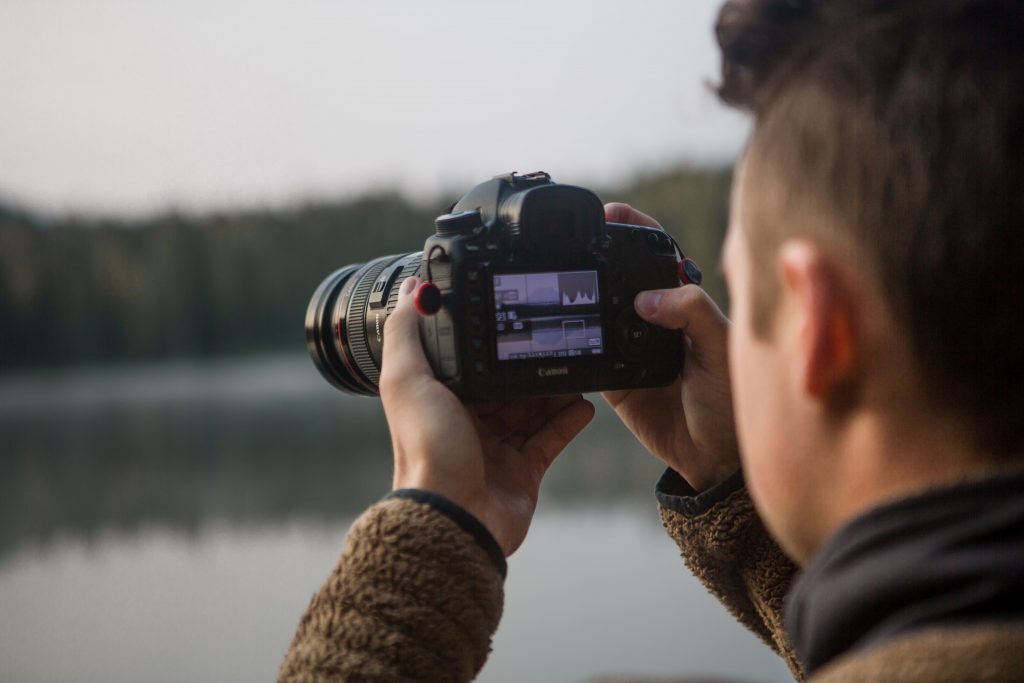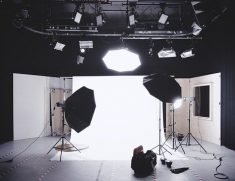Last updated on December 7th, 2023
Exposure bracketing is an invaluable tool used by photographers to capture a variety of exposure levels. Exposure bracketing captures multiple exposures or frames simultaneously with subtle exposure adjustments. For example, you might take three shots of the same scene: one overexposed, one regular exposure, and one underexposed – which creates exposure bracketing. By capturing three frames of the same exposure, photographers can better ensure they get a correctly exposed image in their final photo.

Why Should You Exposure Bracket?
The purpose of taking three shots is in case the camera was ‘fooled’ by an imbalance of light, resulting in your primary subject being over- or underexposed. By taking multiple photos, you can avoid this issue altogether.
Landscape photographers sometimes refer to bracketed shots as “safety shots” because they increase the chance of getting a great photo. Exposure bracketing is often used when capturing high-contrast scenes or landscapes with bright and dark areas. By using exposure bracketing, you can capture a variety of exposure levels within the same exposure. This ensures you get an image that adequately captures all the details in a scene without any areas being too bright or dark.
When is Exposure Bracketing Helpful?
Exposure bracketing can also be helpful when photographing in tricky lighting conditions and taking long exposure shots at night. By capturing multiple frames with different exposure settings, you’re more likely to get an image that looks good, even with tricky exposure levels.
When there’s too much light
To illustrate, let’s pretend you’re trying to take a picture of your subject matter in an environment with lots of light (for example, at the beach on a sunny day or surrounded by snow). If you use Weighted-Average metering in this case, your camera might be ‘deceived’ into thinking there is more light than there is.
As a result, it would compensate for the lack of light by closing down the aperture and using a faster shutter speed (assuming ISO is constant), which would then cause the main subject to be under-exposed. By taking an extra shot that’s slightly overexposed, however, you’d be able to properly expose your surroundings without sacrificing exposure quality for your main subject.
When it’s too dark
On the other hand, if your surroundings are too dark, the camera will open up the aperture and use a slower shutter speed to expose the lack of light (assuming ISO is constant). However, this might cause your main subject to be over-exposed.
To solve this problem, take an extra shot at a slight under-exposure. This will underexpose your surroundings but properly expose your main subject.
For post-processing
Exposure bracketing can also help when processing your photos in post-production. When processing HDR (high dynamic range) images, you can use exposure bracketed frames to create a photo with an extended range of brightness and color depth. You can easily create an HDR image with great depth and detail by having multiple exposure levels for the same scene.
Can You Use Exposure Bracketing in Manual Mode?
There are two main ways to use exposure bracketing: manually and automatically. Manual exposure bracketing requires you to adjust exposure settings for each frame. This can be time-consuming and difficult, especially in high-contrast scenes.
How To Manually Take Bracketed Exposures
To manually use exposure bracketing, you will need to take three photos of the same exposure: one exposure that is brighter than the exposure you would typically use, one exposure at your “normal” exposure setting, and one exposure that is darker than usual. The amount of exposure adjustment you make for each frame will depend on the scene and its dynamic range. It’s going to go something like this:
- Get your tripod ready (your photos will come out better using one). Take a photo of your scene at the exposure you would typically use.
- Then, you want to change the exposure compensation, shutter speed, or ISO by approximately one stop and take a second exposure that is either brighter or darker than the first.
- Finally, adjust your exposure settings again, this time shutter speed and ISO by two stops, and take the third exposure. Make sure to lock in the exposure setting for each frame, so you don’t accidentally change them between shots.
What Is AEB Or Auto Exposure Bracketing?
Alternatively, you can use auto exposure bracketing (AEB). This mode automatically adjusts exposure for each frame according to your chosen exposure settings. This eliminates the need to adjust exposure levels manually. Auto exposure bracketing is especially useful for capturing high-contrast scenes with precise exposure adjustments.

How to Take Automatic Bracketed Exposures
The first thing you need to do is set your exposure settings. You can do this in the camera’s exposure mode or via manual exposure controls. Once you decide on an exposure setting, you can switch to AEB mode and capture exposures. Most cameras will capture three exposure levels: overexposed, regular exposure, and underexposed. You can also specify the exposure adjustment for each frame.
Most DSLRs come with AEB. To enable it, select exposure bracketing mode in the camera’s menu. Then, set the exposure range you wish to use for each exposure level (typically -2, 0, +2). The camera will adjust exposure for each frame with your specified range.
What Is The Best Way To Manage Exposure Bracket
Next, you need to press the shutter button. Depending on your camera, exposure bracketing may come with its shutter button, or you may have to use the standard shutter button. Your exposure settings will then be applied to each exposure level automatically.
How fast do you need the exposure bracketing to happen?
The speed at which exposure bracketing occurs depends on your camera’s shutter speed. Shutter speeds of 1/500th of a second or faster will allow exposure bracketing to occur quickly, while slower shutter speeds may require longer exposure times for exposure bracketing to occur.
Compositing Exposures
Once you’ve captured exposure bracketed frames, editing is pretty straightforward. Several image-editing applications can composite the exposures into a single image. This will allow you to create an HDR image that combines all exposure levels into one frame.
What’s the best way to manage exposure bracketing in post?
Once you have taken your exposure bracketed images, the next step is post-processing. You can merge the exposure frames using software like Photoshop or Lightroom. This will combine the exposure frames into a single image and allow you to adjust exposure levels, contrast, white balance, and other settings until you get the desired exposure level.
FAQs: Exposure Bracketing Common Questions
When is exposure bracketing not helpful?
Exposure bracketing is only sometimes the best solution for every situation. Exposure bracketing may not be necessary if you’re shooting a scene with no exposure extremes.
Additionally, exposure bracketing can take up a lot of time and memory space on your camera, so it’s wise to consider if it’s the best solution for the given circumstance.
Is exposure the only thing that can be bracketed?
No! Exposure bracketing is one of many types of bracketing you can use. Other types of exposure bracketing include white balance, flash exposure, and focus bracketing. You can also use bracketing for other settings, such as ISO and shutter speed.
When using exposure bracketing, it’s important to remember that each frame should have a slightly different exposure setting. Too much of a difference may make the frames look too disparate, while too little exposure difference will result in multiple pictures of the same exposure.
Should I bracket my scene if no detail is being clipped?
Even if a scene has no exposure extremes, bracketing your shots can create dynamic range effects and allow you to capture more detail than usual. By taking three different exposures of the same shot (one underexposed, one usually exposed, and one overexposed), you can get more excellent contrast, and color depth in a photo than your camera’s sensor would otherwise be able to capture.
Conclusion: What is Exposure Bracketing?
Overall, exposure bracketing is a great tool for photographers to capture the best exposure settings in any scene or lighting condition. With exposure bracketing, you’re able to take multiple frames of the same exposure and use them to craft an image with a greater exposure range than what is possible with a single exposure. With exposure bracketing, you can be sure that you’re capturing the best exposure levels for any scene or lighting condition. So what are you waiting for? Start exposure bracketing and take your photography to the next level!


